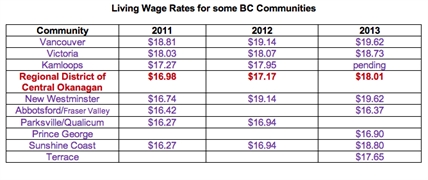The 2013 Living Wage calculation for the Regional District of Central Okanagan is up an average 4.9% over the previous year`s figure ($17.17). To keep the two parent, two child household out of extreme poverty, each adult must be employed full-time and earn at least $18.01 per hour in order to meet their family`s most basic needs.The Regional District`s Social Development Program Coordinator says, “While most categories used for the Living Wage calculation increased slightly, there was a notable jump in the costs associated with Child Care. This expense rose approximately 8.5% or $89 per month over 2012.`` Christene Walsh adds, ``Also adding to the increased challenge facing Central Okanagan families is a 4.5% rise in the cost of transportation to just over $492 a month in 2013.The calculation is based on an established format from the Canadian Centre for Policy Alternatives and is endorsed provincially by First Call: BC Child and Youth Advocacy Coalition (which maintains the Living Wage for Families website). It reflects the actual costs of living in a community and is different from the Minimum Wage, which is a minimum rate of pay legislated by the Provincial Government. The Central Okanagan Living Wage calculation (Central Okanagan Living Wage Table) includes expenses such as food, rent, transportation, child care and education expenses; all considered the basic needs of any family. Government taxes, credits, deductions and subsidies are also included in the calculations. Other real life costs such as debt repayment, entertainment (cable, internet), special care of a relative, cigarette smoking and saving for or acquiring home ownership are not part of the Living Wage calculation.
DON QUIXOTE VS. CITY HALL When an American gets mad, he says "where's my Gun". When a Canadian gets pissed off he says "Where is my pen, I'm going to send a letter to the EDITOR". When the EDITOR won't publish his letter he sets up his own BLOG page. When I received enough support to get a Council Seat the dogma of the establishment became : "Better to have him inside the tent pissing out, than outside pissing in." (Only time will tell !)
Tuesday, July 23, 2013
3rd Annual Central Okanagan Living Wage Report
July 23, 2013 - 1:02 PM Info-Tel Multimedia
For the third time in as many years, there`s been a rise in the Living Wage required by each pair of working members of a four person Central Okanagan family.
The 2013 Living Wage calculation for the Regional District of Central Okanagan is up an average 4.9% over the previous year`s figure ($17.17). To keep the two parent, two child household out of extreme poverty, each adult must be employed full-time and earn at least $18.01 per hour in order to meet their family`s most basic needs.The Regional District`s Social Development Program Coordinator says, “While most categories used for the Living Wage calculation increased slightly, there was a notable jump in the costs associated with Child Care. This expense rose approximately 8.5% or $89 per month over 2012.`` Christene Walsh adds, ``Also adding to the increased challenge facing Central Okanagan families is a 4.5% rise in the cost of transportation to just over $492 a month in 2013.The calculation is based on an established format from the Canadian Centre for Policy Alternatives and is endorsed provincially by First Call: BC Child and Youth Advocacy Coalition (which maintains the Living Wage for Families website). It reflects the actual costs of living in a community and is different from the Minimum Wage, which is a minimum rate of pay legislated by the Provincial Government. The Central Okanagan Living Wage calculation (Central Okanagan Living Wage Table) includes expenses such as food, rent, transportation, child care and education expenses; all considered the basic needs of any family. Government taxes, credits, deductions and subsidies are also included in the calculations. Other real life costs such as debt repayment, entertainment (cable, internet), special care of a relative, cigarette smoking and saving for or acquiring home ownership are not part of the Living Wage calculation.
The 2013 Living Wage calculation for the Regional District of Central Okanagan is up an average 4.9% over the previous year`s figure ($17.17). To keep the two parent, two child household out of extreme poverty, each adult must be employed full-time and earn at least $18.01 per hour in order to meet their family`s most basic needs.The Regional District`s Social Development Program Coordinator says, “While most categories used for the Living Wage calculation increased slightly, there was a notable jump in the costs associated with Child Care. This expense rose approximately 8.5% or $89 per month over 2012.`` Christene Walsh adds, ``Also adding to the increased challenge facing Central Okanagan families is a 4.5% rise in the cost of transportation to just over $492 a month in 2013.The calculation is based on an established format from the Canadian Centre for Policy Alternatives and is endorsed provincially by First Call: BC Child and Youth Advocacy Coalition (which maintains the Living Wage for Families website). It reflects the actual costs of living in a community and is different from the Minimum Wage, which is a minimum rate of pay legislated by the Provincial Government. The Central Okanagan Living Wage calculation (Central Okanagan Living Wage Table) includes expenses such as food, rent, transportation, child care and education expenses; all considered the basic needs of any family. Government taxes, credits, deductions and subsidies are also included in the calculations. Other real life costs such as debt repayment, entertainment (cable, internet), special care of a relative, cigarette smoking and saving for or acquiring home ownership are not part of the Living Wage calculation.
Subscribe to:
Post Comments (Atom)

No comments:
Post a Comment